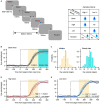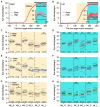Sensorimotor-linked reward modulates smooth pursuit eye movements in monkeys
- PMID: 38264498
- PMCID: PMC10803645
- DOI: 10.3389/fnins.2023.1297914
Sensorimotor-linked reward modulates smooth pursuit eye movements in monkeys
Abstract
Reward is essential for shaping behavior. Using sensory cues to imply forthcoming rewards, previous studies have demonstrated powerful effects of rewards on behavior. Nevertheless, the impact of reward on the sensorimotor transformation, particularly when reward is linked to behavior remains uncertain. In this study, we investigated how reward modulates smooth pursuit eye movements in monkeys. Three distinct associations between reward and eye movements were conducted in independent blocks. Results indicated that reward increased eye velocity during the steady-state pursuit, rather than during the initiation. The influence depended on the particular association between behavior and reward: a faster eye velocity was linked with reward. Neither rewarding slower eye movements nor randomizing rewards had a significant effect on behavior. The findings support the existence of distinct mechanisms involved in the initiation and steady-state phases of pursuit, and contribute to a deeper understanding of how reward interacts with these two periods of pursuit.
Keywords: initiation; reward; smooth pursuit eye movements; steady state; visual motion.
Copyright © 2024 Hu, Wang, Joshua and Yang.
Conflict of interest statement
The authors declare that the research was conducted in the absence of any commercial or financial relationships that could be construed as a potential conflict of interest. The author(s) declared that they were an editorial board member of Frontiers, at the time of submission. This had no impact on the peer review process and the final decision.
Figures







References
LinkOut - more resources
Full Text Sources

